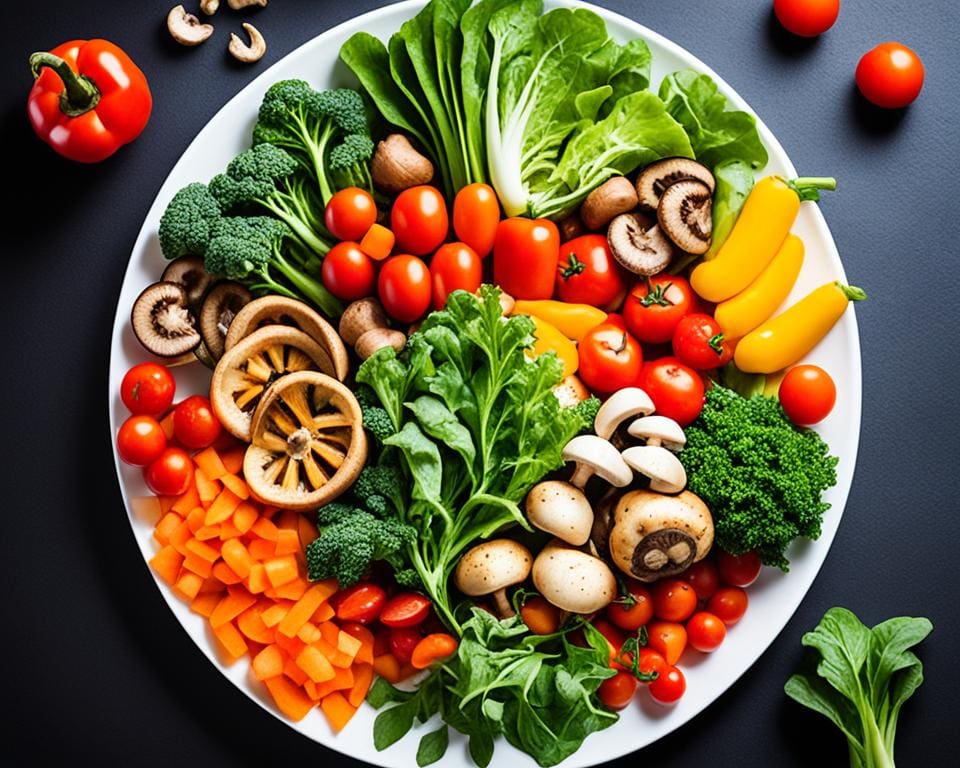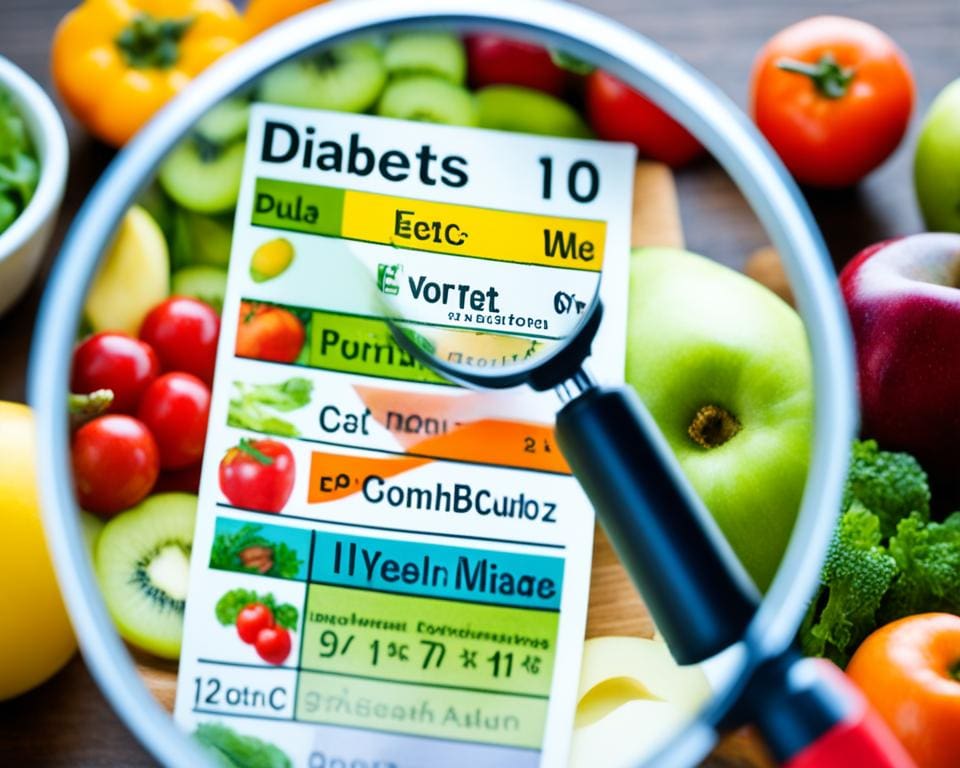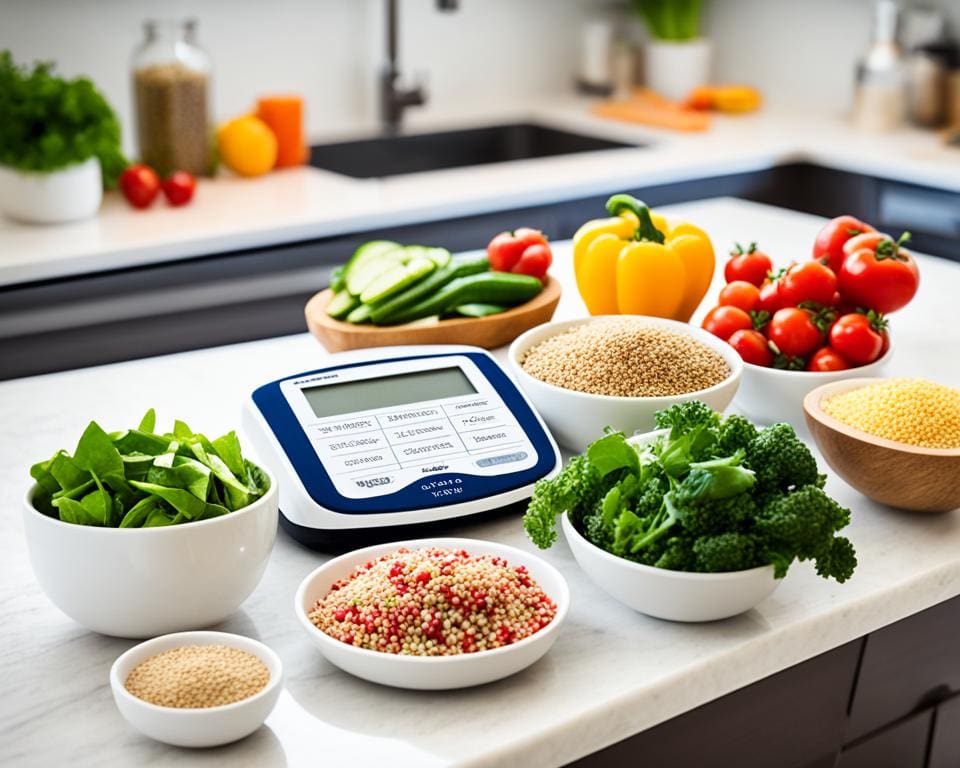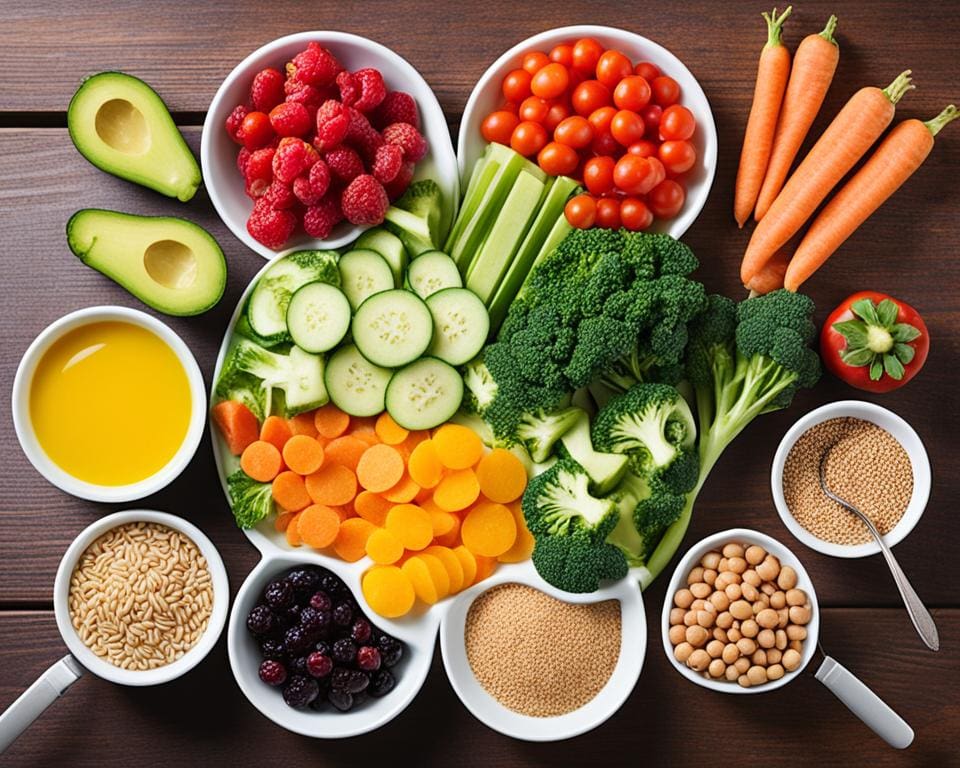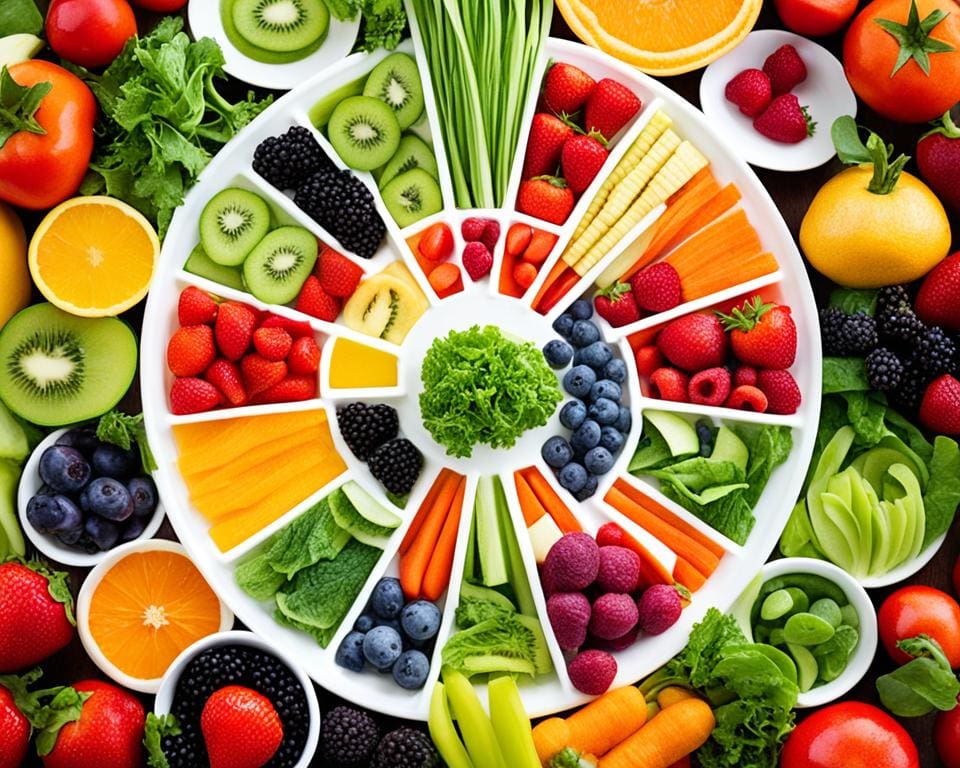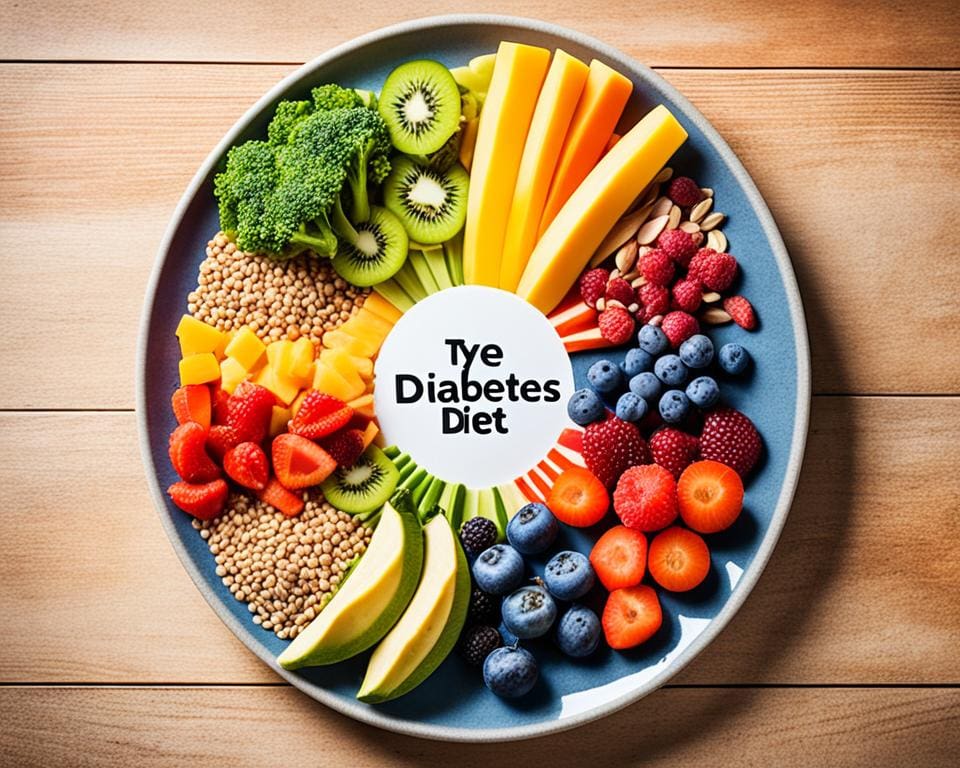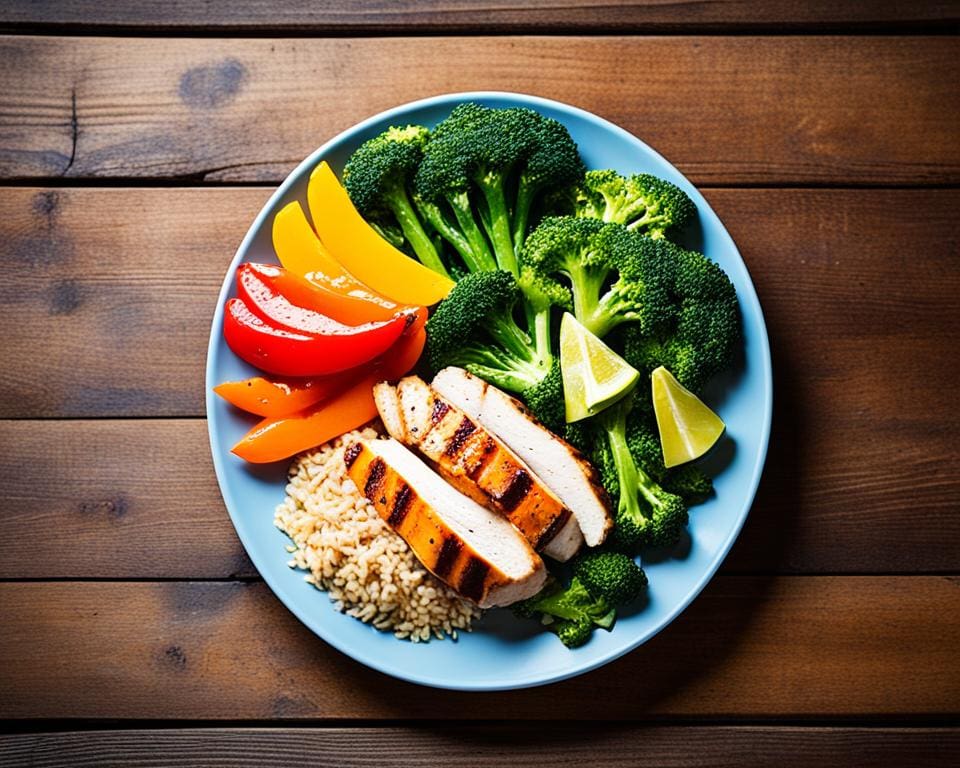Eating a mix of vegetables is key to managing type 2 diabetes and even reversing it. Vegetables are full of nutrients, fiber, and antioxidants. These can help lower blood sugar levels, fight inflammation, and boost health.
When managing diabetes, meal planning is vital to avoid blood sugar highs. Vegetables are great for your plate because they’re low in calories and carbs but high in fiber. For example, a cup of raw spinach has just 1g of carbs but is packed with vitamin A, a strong antioxidant1.
Choosing a variety of vegetables makes meals more interesting and ensures you get many nutrients. Tomatoes, for instance, have less than 5g of carbs per medium tomato and are full of vitamin C and lycopene1. Broccoli is another top pick, with under 5g of carbs per cup raw, loaded with vitamin C, fiber, and iron1.
Adding vegetables like cabbage, Brussels sprouts, cauliflower, and asparagus boosts your nutrient intake and keeps carbs low1. By picking low-glycemic index veggies and watching portion sizes, you can make tasty meals that help manage diabetes and aid in reversing it.
Key Takeaways:
- Vegetables are crucial for managing type 2 diabetes and reversing it
- Plan meals with care, considering portion sizes and carbs
- Choose a variety of vegetables for a broad nutrient intake
- Focus on low-glycemic index vegetables to prevent blood sugar spikes
- Add nutrient-rich options like spinach, tomatoes, broccoli, and cabbage
The Importance of Vegetables for Diabetes Management
Eating a variety of vegetables is key to managing type 2 diabetes and lowering insulin resistance. A study showed that 37% of people went into full diabetes remission by eating a whole-food, plant-based diet2. Vegetables are low in calories and carbs, making them great for those wanting to lower A1C levels and balance blood sugar3.
Leafy greens like spinach, kale, and collard greens are packed with vitamins, minerals, and antioxidants. These help control blood sugar and boost insulin production3. They also protect against diabetes-related eye problems like cataracts and macular degeneration3.
“Dietary factors are a leading contributor to morbidity and mortality worldwide.”4
High-fiber foods, including veggies, slow down blood sugar spikes and reduce cravings and overeating2. Fiber supports healthy digestion and helps control hunger3. Eating more plants can make you more sensitive to insulin and help you stick to your diet2.
Non-starchy veggies like beans, peas, carrots, mushrooms, bell peppers, onions, and asparagus are great for diabetes management3. They give steady energy without affecting blood sugar much and keep you feeling full, preventing unhealthy snacking3.
Managing diabetes means eating a balanced diet with lots of fiber, lean proteins, fruits, veggies, and complex carbs, and avoiding refined sugars2. Adding more whole and plant-based foods and choosing protein sources like nuts, seeds, and pulses can improve your glucose control and help you follow a plant-based diet2.
Studies suggest eating more veggies, fruits, whole grains, legumes, nuts, and dairy like yogurt can fight diabetes worldwide4. By making veggies a big part of your meals, you can better manage your diabetes and lower the risk of its complications. Embrace plants for better insulin resistance and health.
Antioxidant-Rich Vegetables for Diabetes
Vegetables full of antioxidants are great for people with diabetes. These compounds protect cells from damage by free radicals. This can help prevent chronic diseases like type 2 diabetes5. Eating a mix of these vegetables can help control blood sugar, lower inflammation, and boost health5.

Vitamin A and Carotenoid-Rich Vegetables
Vitamin A and carotenoids, like beta-carotene, are key antioxidants in many veggies. Sweet potatoes, spinach, carrots, and peppers are great sources. Spinach is packed with 2.86 grams of protein and 2.20 grams of fiber per 100 grams6. These nutrients help with feeling full and keeping blood sugar stable5.
Vitamin C-Rich Vegetables
Vitamin C fights inflammation and boosts the immune system. Red peppers, broccoli, Brussels sprouts, and tomato juice are full of it. Brussels sprouts offer 3.38 grams of protein and 3.80 grams of fiber per 100 grams6. Eating these veggies can support health and lower diabetes risk5.
Vitamin E-Rich Vegetables
Vitamin E protects cell membranes from damage. Spinach, broccoli, tomatoes, vegetable oils, and nuts are good sources. Broccoli gives you 2.57 grams of protein and 2.40 grams of fiber per 100 grams6. Adding these to your diet can help with heart health and diabetes prevention5.
Phenol-Rich Vegetables
Phenolic compounds are antioxidants in many veggies. Spinach, cabbage, broccoli, red peppers, and onions are full of them. These veggies are also high in fiber, which helps with blood sugar control and digestion5.
Flavonoid-Rich Vegetables
Flavonoids reduce inflammation and improve heart health. Onions, kale, rutabaga, turnip greens, watercress, broccoli, and fava beans are top sources. Many of these have a low glycemic index, meaning they don’t spike blood sugar levels5.
| Vegetable | Antioxidant | Protein (per 100g) | Fiber (per 100g) |
|---|---|---|---|
| Spinach | Vitamin A, Vitamin E, Phenols | 2.86 g | 2.20 g |
| Brussels Sprouts | Vitamin C | 3.38 g | 3.80 g |
| Broccoli | Vitamin C, Vitamin E, Phenols, Flavonoids | 2.57 g | 2.40 g |
| Red Peppers | Vitamin A, Vitamin C, Phenols | 0.99 g | 2.10 g |
| Onions | Phenols, Flavonoids | 1.10 g | 1.70 g |
Eating a variety of antioxidant-rich veggies is key to managing diabetes and boosting health. Try to eat a rainbow of colors to get different nutrients and antioxidants5. By making these veggies a big part of your meals, you can fight inflammation, stabilize blood sugar, and improve your health5.
Nitrate-Rich Vegetables for Cardiovascular Health
Eating nitrate-rich vegetables can help keep your heart healthy and manage diabetes. Studies show that eating more vegetables with nitrates can lower blood pressure. People eating the most nitrate-rich vegetables had lower blood pressure than those eating the least7.
This drop in blood pressure comes from turning dietary nitrate into nitrite. Nitrite helps protect blood vessels and prevent blood clots8.

Having about 59 mg of vegetable nitrate a day can cut the risk of heart disease by 15%. It also lowers the risk of other heart problems like stroke and artery disease7. Eating 60 mg of vegetable nitrate a day, found in 1 cup of leafy greens, can help prevent heart disease7.
A typical American eats 75 to 100 mg of nitrates daily9. While processed meats with added nitrates are not good for health, natural nitrates in veggies are beneficial. Spinach, for example, has a lot of nitrates, as do bok choy, lettuce, and carrots9.
Studies look at how nitrates and nitrites in food can be good for health8.
Research shows that the nitrate-nitrite-NO pathway is key to getting health benefits from dietary nitrates. This pathway involves gases like NO, CO, and H2S, which help with blood clotting and preventing blood clots8. Supplements and beet juice have been studied for their effects on heart health and strength8.
To boost your heart health and control blood pressure, add these nitrate-rich veggies to your meals:
- Beets
- Spinach
- Arugula
- Lettuce
- Bok choy
- Carrots
- Celery
- Radishes
By eating these veggies often, you can use dietary nitrates to support your heart health and manage diabetes.
Protein-Rich Vegetables for Satiety and Blood Sugar Control
Eating protein-rich vegetables can help manage diabetes by making you feel full and keeping blood sugar stable. Protein slows down digestion, which helps control how fast nutrients get into your blood. This can prevent sudden spikes in blood sugar, making diabetes easier to manage.

Protein makes the pancreas release insulin, a hormone that lowers blood sugar after eating. Adding protein-rich vegetables to your meals helps control blood sugar and lowers the risk of diabetes problems10.
Daily Protein Recommendations for People with Diabetes
The amount of protein you need varies based on your size, sex, and activity level. Generally, you should aim for 0.8 grams of protein per kilogram of body weight. But, people with diabetes might need more or less protein depending on their health and treatment.
It’s important to talk to a healthcare professional or dietitian to find out how much protein you need. They can look at your health, lifestyle, and goals to give you the right amount of protein to eat every day.
Vegetables Containing Protein
Many think of protein as coming from meat, poultry, and dairy. But, there are many vegetables that are great sources of plant-based protein. These veggies can help you get enough protein and give you important vitamins, minerals, and fiber. Some top protein-rich vegetables are:
- Spinach
- Bok choy
- Asparagus
- Mustard greens
- Brussels sprouts
- Broccoli
- Cauliflower
Adding these veggies to your meals can make you feel full for a longer time. This can help people with diabetes stay at a healthy weight and control their blood sugar better.
These vegetables are also high in fiber, which makes you feel more full and slows down glucose absorption10. By eating protein and fiber-rich vegetables, you can manage your blood sugar and lower the risk of diabetes problems.
Fiber-Rich Vegetables for Digestive Health and Glucose Control
Eating fiber-rich veggies can boost your health in many ways. Most Americans don’t get enough fiber11. The 2020–2025 Dietary Guidelines suggest adults aim for 22 to 34 grams of fiber daily11. Sadly, only 5% of Americans meet this goal12.
There are two types of fiber in veggies: soluble and insoluble. Soluble fiber is in foods like apples, bananas, and avocados11. Insoluble fiber is in whole wheat flour and many fruits and veggies11.
Benefits of Fiber for Diabetes Management
Eating a fiber-rich diet helps people with diabetes. A 2018 study showed more fiber means lower blood sugar levels12. Insoluble fiber helps move food through your body, preventing constipation12.
Recommended Daily Fiber Intake
The American Diabetes Association suggests 22–35 grams of fiber daily for adults12. Foods are labeled “high” in fiber if they offer at least 20% of your daily fiber needs12. “Good” fiber products have 10% of your daily fiber, or 2.5 to 5 g12.
Vegetables High in Both Protein and Fiber
Some veggies are great for protein and fiber, helping with weight and blood sugar control. Here are a few:
| Vegetable | Fiber Content | Protein Content |
|---|---|---|
| Lentils (1 cup) | 15.6 g13 | 18 g13 |
| Artichokes (½ cup) | 4.8 g13 | 2 g |
| Green Peas (½ cup) | 3.5 g13 | 4 g |
| Broccoli (1 cup, chopped) | 2 g13 | 2.5 g |
| Brussels Sprouts (1 cup) | 3.4 g12 | 3 g |
Other fiber-rich foods include almonds, chia seeds, hummus, bananas, kale, and sweet potatoes12.
When upping your fiber, do it slowly to avoid digestive issues like bloating and gas11.
Adding fiber-rich veggies to your diet helps with digestion, weight, and glucose control. This is key for people with diabetes.
Low Glycemic Index Vegetables for Blood Sugar Management
The glycemic index (GI) ranks foods by how they affect blood sugar levels. It uses a scale from 0 to 100. Foods with little effect on blood sugar levels are at the low end. Those with big effects are at the high end14. A low-GI diet includes foods in three categories: Low GI (1 to 55), Medium GI (56 to 69), and High GI (70 and higher)14.
To find the GI, researchers compare how a food affects blood sugar to sugar itself14. For example, cantaloupe’s GI is between 65 to 7014. The Glycemic Load (GL) shows how a common food portion affects blood sugar, from Low GL (1 to 10) to High GL (20 or more)14.

For managing blood sugar, eat green veggies, most fruits, raw carrots, kidney beans, chickpeas, and lentils14. Non-starchy veggies are low in carbs and calories but high in fiber, helping control blood sugar15. Dark leafy greens are full of vitamins and minerals, low in carbs, and high in fiber, aiding in blood sugar control16.
Other veggies rich in fiber and low in carbs include onions, mushrooms, zucchini, broccoli, celery, and Brussels sprouts16. A 2022 review in Molecules found that cucumbers may help lower and control blood sugar levels15.
Studies show a low-GI diet can help with weight loss, lower blood pressure, and improve diabetes management14.
But, the quality of food in a low-GI diet matters more than just the GI value14. Many factors affect glucose absorption, so GI isn’t always a reliable guide for diabetes. Focus on healthy eating and nutrient-rich foods for blood sugar control and overall health14.
| Low GI Vegetables (1-55) | Medium GI Vegetables (56-69) | High GI Vegetables (70+) |
|---|---|---|
| Asparagus, Broccoli, Cauliflower, Celery, Cucumber, Green Beans, Kale, Lettuce, Mushrooms, Onions, Peppers, Spinach, Tomatoes, Zucchini | Beets, Carrots, Peas, Sweet Potatoes | Parsnips, Potatoes, Pumpkin, Rutabaga, Turnips |
Starchy veggies like potatoes and corn are also good for you, but count them as carb servings15. The CDC suggests getting half your calories from carbs, with each gram of carb equaling four calories16. Eating steady carbs at meals helps keep blood sugar stable all day16.
The Benefits of Choosing a Variety of Vegetables
Eating a mix of vegetables is key for good health, especially if you have diabetes. Each vegetable type gives you different vitamins, minerals, and antioxidants. These nutrients help keep you healthy17. By eating many vegetables, you make sure your body gets all the nutrients it needs18.

Vegetables are packed with energy from complex carbs. These carbs don’t cause blood sugar spikes like simple carbs in sweets do. Carrots, for example, help keep blood sugar levels stable, making them great for a diabetes diet18.
Beets are full of nitrates, which can lower the risk of heart disease, a diabetes complication17. Fatty fish like salmon and anchovies are also good for the heart. They have omega-3 fatty acids that protect against diabetes-related heart issues18.
Eating many vegetables helps with weight control. They’re low in calories but high in fiber, making you feel full and satisfied. Chia seeds are a good example. They’re high in fiber and low in carbs, helping to control blood sugar in type 2 diabetes1718.
“By eating a rainbow of vegetables, you provide your body with the essential vitamins, minerals, and antioxidants it needs to thrive, while also supporting healthy blood sugar levels and overall well-being.”
Adding a variety of vegetables to your meals and snacks is simple and tasty. Try different cooking methods like roasting, grilling, or sautéing to find new flavors. Make sure vegetables are a big part of your diet for their many health benefits.
Health Tips for Eating Vegetables with Type 2 Diabetes
Start by choosing fresh foods when adding vegetables to your diet for type 2 diabetes. Fill half your plate with colorful non-starchy veggies like broccoli, bell peppers, and carrots19. Pick fresh or steamed veggies lightly dressed for the best health perks19.
For tasty veggies without extra calories or salt, try herbs, spices, or low-salt seasonings. Lemon juice or vinegar pepper sauce can add flavor too. Cooking methods like boiling, baking, grilling, or roasting with a bit of oil are healthier than frying20.
Keep vegetable peels on when you can to increase fiber, which helps with blood sugar and digestion20. Foods high in fiber like veggies, fruits, nuts, and whole grains are key for blood sugar control20. The American Diabetes Association suggests that half your meals should be nonstarchy veggies21.
“Eating a variety of vegetables is key to obtaining a wide range of essential nutrients and antioxidants that can help manage diabetes and improve overall health.”
Opt for raw veggies when you can, as they’re often more nutritious. But add high-fiber foods slowly to avoid stomach issues. A doctor or dietitian can tailor a diet plan for you, considering your needs and likes.
Small changes, like eating more fresh veggies, using low-salt seasonings, and cooking healthily, can greatly improve your diabetes care and health.
Easy Vegetable-Based Meal Ideas and Recipes
Adding more veggies to your meals is easy and fun. With some creativity and great recipes, you can make tasty, healthy meals. Dr. Elina Tomski, MD, turned her health around by eating more plants for 4 months22. Her story shows how plant-based eating can boost your health.
Simple Vegetable-Based Meal Options
Here are some easy veggie meals you can add to your daily meals:
- Hard-boiled eggs and roasted beets with black pepper and turmeric
- Cottage cheese spread on toasted sweet potato slices with black or cayenne pepper
- Spinach leaf salad with chia seeds, tomatoes, bell peppers, and goat’s cheese
- Yellow and zucchini squash with quinoa, peppers, onions, and diced tomatoes with scrambled egg
- Cottage cheese with mixed greens and veggie salad
These meals are easy to make and full of nutrients to help control your blood sugar. Each recipe has less than 575 calories, 6 grams of bad fat, and 750 milligrams of sodium23. They’re perfect for a diet that’s good for diabetes.
Delicious Vegetable-Based Recipes to Try
For more complex recipes, try these tasty veggie dishes:
- Spinach, chickpea, and tomato stew
- Roasted Brussels sprouts with garlic
- Baked kale chips
- Roasted onions
- Easy vegetable soup
These recipes show how versatile veggies can be. For example, a quick Indian chickpea curry can be made fast with canned beans23. Also, a veggie burger recipe uses a special cooking method for great taste and texture23.
Trying out recipes with peaches and golden beets led to a delicious Peach and Golden Beet Soup24. The Moroccan Vegetable and Chickpea Stew is great with couscous or pita bread24. These recipes inspire you to be creative with veggies and make meals that are both tasty and healthy.
“Eating a variety of vegetables is key to reversing diabetes. By incorporating different types of vegetables into your meals, you can ensure that you’re getting a wide range of nutrients that can help improve your overall health.” – Dr. Elina Tomski, MD22
By adding these veggie meals and recipes to your diet, you’re taking a big step towards managing diabetes and improving your health. Remember, even small changes can make a big difference. Start adding more veggies to your meals today!
Making the Most of Vegetables in Your Diet
Adding a variety of vegetables to your meals is crucial for managing diabetes and boosting health. Focus on balanced meals, smart snacking, and eating a range of colors. This approach helps control blood sugar and improves your health.
Balancing Your Plate with Non-Starchy Vegetables
Try to fill half your plate with non-starchy vegetables. They are low in calories and carbs but packed with vitamins, minerals, and fiber. Eating a diet full of vegetables, fruits, whole grains, legumes, and nuts helps control blood sugar and improves insulin use25.
Use a quarter of your plate for complex carbs like sweet potatoes or whole grains. The other quarter for lean proteins such as fish, chicken, beans, or lentils26. This meal plan helps keep blood glucose stable and gives you energy all day.
Snacking on Raw Vegetables
For snacks, choose raw vegetables. Options like celery sticks, baby carrots, and sliced bell peppers with hummus or Greek yogurt are great. They’re filling and full of fiber and nutrients. Raw veggies are better than processed snacks for keeping blood sugar stable and helping with weight control2627.
Choosing a Rainbow of Vegetable Colors
Using a variety of vegetable colors makes your meals look good and gives you many nutrients. Each color has special health benefits, from antioxidants in green veggies to immune support from red and orange ones. Try to have at least three different colors on your plate at meals. Experiment with new veggies to keep your meals interesting.
“Eating a rainbow of colors through a variety of vegetables is one of the most powerful steps you can take to promote long-term health and well-being.”
By focusing on non-starchy vegetables, raw snacks, and a variety of colors, you can manage diabetes and enjoy the tasty, healthy benefits of these foods.
Top 10 Vegetables to Reverse Diabetes
Eating a variety of nutrient-rich vegetables is key to managing and possibly reversing diabetes. With over 37 million Americans living with diabetes and nearly 96 million more at risk, choosing the right foods can greatly improve your health. By eating top vegetables that help control blood sugar, you can improve your health and lower your risk of diabetes complications.
Studies show that eating more leafy greens can lower your risk of type 2 diabetes by 14%. Each daily serving of these greens can cut the risk by 9%28. Diet, especially, affects insulin resistance29. Adding these top 10 vegetables to your meals can help reverse diabetes and boost your health:
- Carrots – High in fiber and vitamin A, which support healthy vision and immune function.
- Broccoli – Acts as a prebiotic, promoting the growth of beneficial gut bacteria.
- Zucchini – Contains heart-healthy carotenoids and is low in calories.
- Cabbage – Rich in vitamin C, which aids in collagen production and immune support29.
- Spinach – Nutrient-dense and may help improve insulin sensitivity.
- Tomatoes – High in lycopene, an antioxidant that supports heart health.
- Cucumber – Hydrating and may help lower blood sugar levels.
- Lettuce – High in fiber, water, and vitamin K, promoting healthy digestion and bone health.
- Mushrooms – May help counteract metformin-related B-vitamin deficiency.
- Green beans – Rich in fiber, vitamin C, and vitamin A, supporting overall health.
In a recent study on type 2 diabetics following a diet of vegetables, nuts, seeds, beans, and fresh fruit, 90% of participants were able to come off all diabetic medications, and the mean HbA1c after one year was 5.8, which is in the non-diabetic (normal) range28.
When adding these top vegetables to your meals, remember that cooking can reduce their nutrient levels29. Try different cooking methods like steaming, roasting, and eating them raw to keep their nutrients. Also, aim for 30 minutes of physical activity daily to help manage diabetes30.
By choosing healthy foods, like smaller portions and foods with less fat, you can lose weight and control diabetes. Losing 5-7% of your weight can prevent or delay diabetes30. Start adding these vegetables to your meals to begin improving your health and reversing diabetes.
The Role of Starchy Vegetables in a Diabetes-Friendly Diet
Non-starchy vegetables are lower in carbs and calories than starchy ones. But, don’t cut out potatoes and corn from your diet if you have diabetes. These veggies are full of nutrients and fiber that help with health31.
But, remember, starchy veggies like potatoes, corn, and peas can raise blood sugar levels. Make sure to count them as carbs when planning your meals. This helps manage your insulin and medication31.
The key to a healthy, diabetes-friendly diet is moderation and variety. Aim to include a diverse range of vegetables, both starchy and non-starchy, to ensure you’re getting a wide array of essential nutrients.
When planning meals, think about the carbs from fruits, beans, and starchy veggies31. A balanced diet for diabetes should have fruits, veggies, whole grains, lean proteins, and low-fat dairy32.
- Aim to have starchy foods every day as part of a balanced diet33.
- Choose nutrient-dense starchy vegetables like sweet potatoes, butternut squash, and peas for added vitamins and minerals.
- Practice portion control by using the plate method, dividing your plate into sections for non-starchy vegetables, high-fiber carb foods, and protein foods31.
For good nutrition and diabetes management, work with your healthcare team. This includes a diabetes educator or registered dietitian. They can help create a meal plan that fits your needs and lifestyle3132.
Conclusion
In conclusion, eating a variety of vegetables is key to managing diabetes. Diabetes affects over 460 million people worldwide34 and more than 34 million in the U.S34.. Eating healthy foods, like vegetables, helps control blood sugar and lowers the risk of complications.
Choosing vegetables high in antioxidants and low on the glycemic index is smart. These foods should be part of your meals and snacks. This approach can boost your health and help manage type 2 diabetes, which is the most common type34. Studies show that losing weight through diet can even reverse type 2 diabetes in some people34. Bariatric surgery has also been linked to diabetes remission rates between 33% and 90%3534.
For better diabetes management, talk to a healthcare expert or dietitian. They can tailor a meal plan for you. By choosing a variety of colorful vegetables, you can greatly improve your health and manage type 2 diabetes well.
FAQ
How can vegetables help manage type 2 diabetes?
Vegetables are full of fiber, antioxidants, and nutrients. These help control inflammation, aid in weight loss, and boost health. They are tasty, filling, and low in calories, making them great for diabetes management.
Can people with diabetes eat any vegetable?
Yes, people with diabetes can eat any vegetable. But, they should plan to avoid blood sugar spikes by watching portion sizes and carbohydrate content. A healthcare professional or dietitian can help create a meal plan that fits their needs and likes.
How do antioxidants in vegetables benefit people with diabetes?
Antioxidants in vegetables fight harmful free radicals and reduce inflammation. They include vitamins A, C, E, and others. Eating a diet rich in these can lower the risk of diabetic complications.
Why are nitrate-rich vegetables important for people with diabetes?
Type 2 diabetes increases the risk of heart disease. Eating nitrate-rich foods like beets and spinach can lower blood pressure and improve heart health.
How do protein-rich vegetables help with diabetes management?
Protein-rich veggies like spinach make you feel full longer, reducing the need for extra snacks. They also help release insulin, which can lower blood sugar after eating.
What role does fiber play in managing diabetes?
Fiber improves digestion, reduces constipation, lowers bad cholesterol, and helps with weight and glucose control. High-fiber veggies like spinach and broccoli make you feel full and prevent sugar spikes.
What is the glycemic index, and how does it relate to vegetables?
The glycemic index measures how foods affect blood sugar levels. Low to medium GI veggies like green peas and carrots don’t cause big sugar spikes, making them good for diabetes.
Why is it important to eat a variety of vegetables?
Eating many vegetables gives you the vitamins, minerals, and antioxidants you need. Different veggies offer various nutrients, ensuring you get a broad range of essential compounds. They’re also filling and low in calories, helping with weight management.
What are some healthy tips for preparing vegetables?
Choose fresh foods when you can, and pick canned items without added sugar or salt. Use herbs and spices for flavor, and cook veggies by boiling, baking, grilling, or roasting instead of frying.
Can starchy vegetables be included in a diabetes-friendly diet?
Yes, starchy veggies like potatoes and corn are fine in a diabetes diet. They’re full of fiber and nutrients. Just remember to count them as carb servings when planning your meals and medication.
Source Links
- https://www.everydayhealth.com/type-2-diabetes/diet/low-carb-veggies-for-diabetic-diets/
- https://www.medicalnewstoday.com/articles/whole-food-plant-based-diet-linked-to-type-2-diabetes-remission
- https://www.ndtv.com/health/heres-why-you-must-include-green-leafy-vegetables-in-your-diabetes-diet-2020889
- https://www.bmj.com/content/361/bmj.k2234
- https://www.healthline.com/health/type-2-diabetes-superfood-recipes
- https://www.medicalnewstoday.com/articles/317225
- https://www.ncbi.nlm.nih.gov/pmc/articles/PMC8416839/
- https://www.ncbi.nlm.nih.gov/pmc/articles/PMC10931520/
- https://www.webmd.com/diet/foods-high-in-nitrates
- https://www.health.com/foods-to-keep-you-full-without-spiking-blood-sugar-7561684
- https://www.cdc.gov/diabetes/healthy-eating/fiber-helps-diabetes.html
- https://www.medicalnewstoday.com/articles/high-fiber-diet-diabetes
- https://www.everydayhealth.com/hs/type-2-diabetes-live-better-guide/fiber-rich-foods-pictures/
- https://www.mayoclinic.org/healthy-lifestyle/nutrition-and-healthy-eating/in-depth/low-glycemic-index-diet/art-20048478
- https://www.eatingwell.com/article/7763406/best-vegetables-for-diabetes/
- https://www.verywellhealth.com/foods-to-lower-blood-sugar-for-diabetes-5215970
- https://www.healthline.com/nutrition/16-best-foods-for-diabetics
- https://www.byramhealthcare.com/blogs/the-10-best-foods-to-control-diabetes-and-lower-blood-sugar
- https://www.cdc.gov/diabetes/healthy-eating/choosing-healthy-foods-holidays.html
- https://www.mayoclinic.org/diseases-conditions/diabetes/in-depth/diabetes-diet/art-20044295
- https://www.hopkinsmedicine.org/health/wellness-and-prevention/prediabetes-diet
- https://cleanfooddirtygirl.com/dr-elina-tomski-reverses-her-pre-diabetes-by-eating-a-whole-food-plant-based-diet-broccoli-cabbage-stir-fry-oil-free/
- https://www.eatingwell.com/gallery/7882620/vegetarian-diabetes-friendly-dinner-recipes/
- https://www.tasteofhome.com/collection/diabetic-vegetarian-recipes/
- https://www.mayoclinic.org/diseases-conditions/diabetes/expert-answers/diabetes/faq-20058117
- https://www.medicinenet.com/what_foods_to_eat_to_reverse_diabetes/ask.htm
- https://www.massgeneralbrigham.org/en/about/newsroom/articles/how-to-control-blood-sugar-with-diet
- https://foodrevolution.org/blog/how-to-eat-to-prevent-diabetes/
- https://www.freedomfromdiabetes.org/blog/post/top-10-vegetables-for-diabetics/2695
- https://www.emoryhealthcare.org/stories/wellness/5-ways-to-reduce-or-even-reverse-diabetes
- https://www.niddk.nih.gov/health-information/diabetes/overview/healthy-living-with-diabetes
- https://medlineplus.gov/diabeticdiet.html
- https://www.diabetes.org.uk/guide-to-diabetes/enjoy-food/eating-with-diabetes/what-is-a-healthy-balanced-diet
- https://www.allmedc.com/can-you-reverse-diabetes
- https://www.ncbi.nlm.nih.gov/pmc/articles/PMC6520897/

